Publication date 08 March 2021
Substantial revision 30 November 2021; Minor revision 4 June 2025
This project conjectures some longer-term possibilities. There are no specific proposals in this project.
The ECML has four tracks from Stoke tunnel, south of Grantham, to London Kings Cross, except between Peterborough and Huntingdon and between Knebworth and Welwyn Garden City. There are only two tracks between Knebworth and Welwyn Garden City including two tunnels in succession, Welwyn North tunnel and Welwyn South tunnel and then Digswell viaduct. This bottleneck might be expected to be working at capacity but for the fact that Welwyn North station is located on the bottleneck.
As Britain responds to climate change, there is always the possibility that railways will move centre stage. If that were to happen, the ECML bottleneck at Welwyn would move up the priority list of issues to be addresssed.
The ECML bottleneck at Welwyn and a Bedford to Cambridge railway are neighbours. Here we will suggest these two projects could be brought together by means of Bedford to Cambridge via the Royston area rather than via Cambourne.
In this article we will hypothesise Elizabeth line services on to the ECML via the West Anglia Main Line (WAML). Elizabeth line services on the ECML could replace some existing services to Kings Cross thereby taking pressure off the two track section between Knebworth and Welwyn Garden City. The terminology employed for this is capacity release. The result in this case is an increase in the overall capacity of the ECML, with some services via Welwyn and some Elizabeth line services.
Let us now discuss the details. In a Network Rail report on capacity of the existing rail network capacity of the rail network (pdf format, opens in new window or tab, usefully searched for Welwyn) page 15 reports under ECML constraints the two track section between Knebworth and Welwyn and with Welwyn North station situated on this two track section.
The Integrated Rail Plan published in November 2021 emphasises the need to upgrade the ECML and remove bottlenecks. The document is available here : Integrated Rail Plan for the North and Midlands (pdf format, opens in new window or tab). The document can be searched for east coast, with pertinent results on pages 14, 76, 84, 113 and 114. On page 114 "The detailed scope for further upgrade of the East Coast Main Line between London and Leeds and the North East, including elements identified by the NPR programme, will be confirmed following a further study."
In this article we will note the potential for Elizabeth line (formerly Crossrail) services on to the ECML. Possible infrastructure is illustrated below. An explanation follows.
Drawings (diagrammatic maps) are displayed full size for clarity.
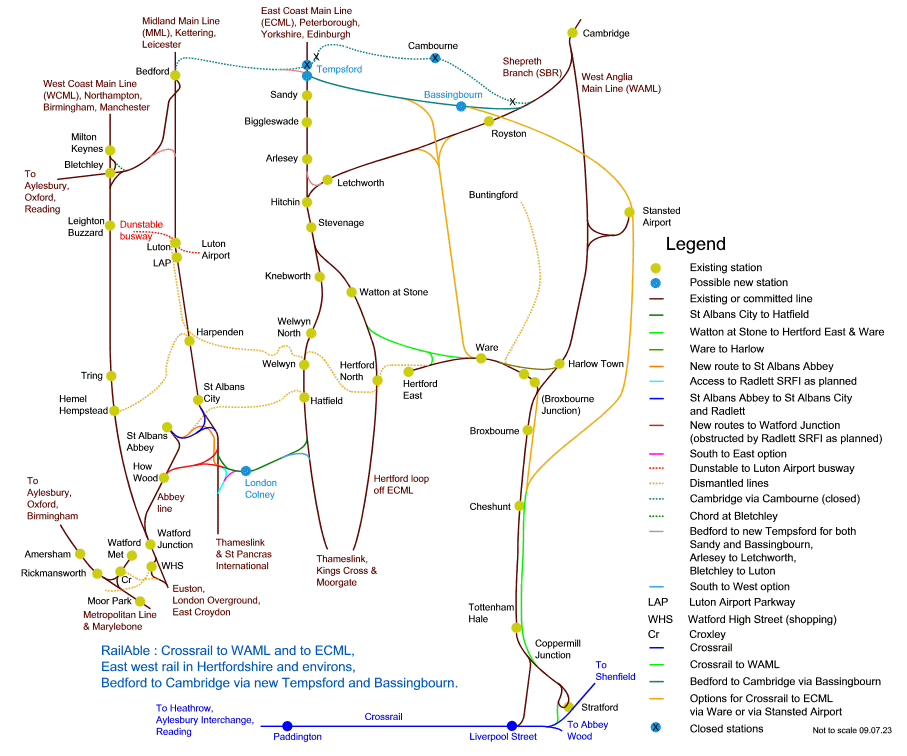
The Elizabeth line is an east-west rail connection between Paddington and Liverpool Street enabled by construction of a tunnel beneath central London. The potential infrastructure for Elizabeth line services on to the ECML is illustrated in light green above. As illustrated, there would be a connection in the Stratford area on to the existing national rail line to Tottenham Hale. From Coppermill Junction possibly as far as Broxbourne Junction the West Anglia Main Line (WAML) would be upgraded to four tracks, an upgrade that has been discussed for some years and the design of much of which has been further refined as part of the Crossrail 2 project. The Crossrail 2 project itself was suspended in November 2020 however we are here noting the potential for that part of the Crossrail 2 project concerned with upgrading the West Anglia Main Line (WAML) to four tracks to proceed.
The third piece of infrastructure for Elizabeth line services on to the ECML, again illustrated in light green, is a connecting line between Ware and Watton at Stone. This connecting line therefore performs two functions, since it is proposed as part of east west rail in Hertfordshire, project : "East west rail - Oxford to Cambridge".
Elizabeth line services on to the ECML at Stevenage would replace one or more existing ECML services via Welwyn and so provide capacity release. In other words, taking pressure off the two track section between Knebworth and Welwyn Garden City by diverting some ECML trains via the WAML. This would serve to ease the constraint on the two track section between Knebworth and Welwyn listed in the Network Rail report, being a matter that has been awaiting resolution for several decades.
On page 18 of the same Network Rail report we read that if the ECML were upgraded between Knebworth and Welwyn to four tracks the next capacity constraint would be on the fast lines south of Hitchin. For this reason we have hypothesised a new line northwards from Ware, coloured yellow above, connecting on to the Shepreth branch (i.e. Hitchin to Cambridge line) westwards to Hitchin and eastwards to Royston. Taking inspiration from the former Buntingford branch but possibly further to the west in order to provide an interchange at Ware, this would provide routes for additional Elizabeth line services via Broxbourne and Ware. As partial or complete replacements for existing services connecting on to the ECML these would release capacity on the ECML not only between Knebworth and Welwyn but also south of Hitchin, thereby responding to the observation on page 18 of the Network Rail report. This is in addition to, or as an alternative to, a connection between Ware and Watton at Stone.
Since originally hypothesising a line northwards from Ware, we have added to our project : "East west rail - Oxford to Cambridge" a facility for services eastwards from Bedford to join the ECML at Tempsford. Clearly services eastwards from Bedford joining the ECML at Tempsford require paths (space/time slots) on the ECML. We are therefore now hypothesising the line northwards from Ware continuing further northwards to provide a junction with the ECML at Tempsford. Services leaving the ECML at Tempsford would release capacity for services from Bedford joining the ECML.
A list of potential services from Bedford joining the ECML at Tempsford is included in our project : "East west rail - Oxford to Cambridge".
Let us ask how an ECML junction at Tempsford and the planned Bedford to Cambridge line relate to eachother.
The East West Railway Company ran a public consultation from 28 January 2019 - 11 March 2019.
There was a consultation document and a technical report. The route options map provided a useful summary.
EWR-Consultation-Document
EWR-Technical-Report
Route options A, B, C, D, E
The technical report reminded us that a Luton - Stevenage corridor, corridor H2, had been ruled out. Corridor H2 was a Hertfordshire County Coucil (HCC) aspiration and which HCC still maintains. We would encourage HCC to abandon the aspiration and replace it with a St Albans - Hatfield corridor, reference our project : "East west rail - Oxford to Cambridge".
The 2019 consultation offered five choices, routes A to E, with the choice of Bedford South or Bedford Midland as an interchange with the Midland Main Line (MML) and a route via Cambourne or via Bassingbourn. In the case of Cambourne, the line interchanged with the ECML in the Tempsford area or south of St Neots. In the case of Bassingbourn, the interchange with the ECML was at Sandy or both at Tempsford and at Sandy.
In the case of Bassingbourn, an interchange with the ECML solely at Tempsford was route L in the technical report but this was not one of the five choices made available in the consultation. We did not respond to the consultation, the significance of the choices made available not being apparent to us at that time. Subsequent to the consultation, route E was selected.
The consultation did not address the question of services from Bedford joining the ECML at Tempsford, which would have been feasible with some of the route options although not route E.
We are now hypothesising a Tempsford to Ware line in circumstances where the consultation has already taken place. A connecting chord from the Tempsford to Ware line on to the Hitchin to Cambridge line provides a route for services from Bedford to Cambridge, possibly via Bassingbourn. This provides an alternative to the Tempsford - Cambourne - Cambridge line currently being planned and we suggest in these circumstances that the Tempsford - Cambourne - Cambridge line would close. We do however find this regrettable.
With hindsight, we would have wished to have responded to the consultation albeit with information we did not have at the time. In terms of the five choices made available, we might have favoured route D. However, as the consultation document states, route D presented difficulties with proximity to the RSPB nature reserve at Sandy and also Biggleswade Common. If these are real difficulties, then we would have suggested putting route L back on the table.
With reference to details of the consultation, any impact of our hypothesised connecting chord from the Tempsford to Ware line on to the Hitchin to Cambridge line, or of route D, on Wimpole Avenue, particularly the view from Wimpole Hall, would be minor in comparison with the existing impact of the A603 and would be further to the south. In particular, we estimate vehicles on the A603 are visible from Wimpole Hall.
If the Tempsford - Cambourne - Cambridge line were to close, Tempsford station might need to be demolished and replaced. The line from Bedford would be redesigned to connect into Tempsford, as shown on our diagrammatic map at the start of this article, rather than on an east-west orientation crossing the ECML at Tempsford, i.e. route E.
We envisage Tempsford as an interchange station for the following: (i) ECML services continuing southwards generally to Kings Cross; (ii) services eastwards from Bedford to Cambridge and to Stratford; (iii) services from Bedford joining the ECML southwards; (iv) services leaving the ECML for Stratford.
For these flows to operate satisfactorily, the station has to be designed without pathing conflicts : a train from Bedford can join the ECML at the same time as a train can leave the ECML for Cambridge or Stratford.
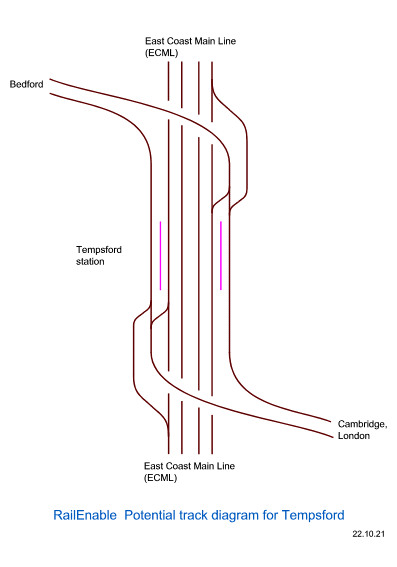
A new line from Tempsford to Stansted Airport as an alternative to a new line to Ware might be worthy of investigation. This would reasonably pass via Bassingbourn where the line would form a junction, for Cambridge connecting on to the Hitchin - Cambridge line and for Stansted Airport crossing the Hitchin - Cambridge line. Alternatively this junction could be located to the west of Bassingbourn. The new line would continue southwards from Stansted Airport.
A new line from Tempsford to Stansted Airport presents some advantages in comparison with a new line to Ware. It provides additional capacity for services from London to Stansted Airport. It avoids what would seem to be some of the difficulties with upgrading the WAML to four tracks, including between Broxbourne and Broxbourne junction (google maps satellite view).
We do not wish to be precise regarding details. The new line southwards from Stansted Airport might at some point form two new tracks alongside the existing tracks of the WAML, as illustrated. Alternatively Elizabeth line services might connect on to the branch to Chingford, not illustrated, which would be extended northwards. It is possible the new line might cross the WAML north of Broxbourne junction and serve Harlow Town, although not joining the existing tracks. This would facilitate a service from Watford to Harlow Town and Stansted Airport, potentially commencing at Euston. It would also offer a dual-track line to Stansted Airport as an alternative to the existing single-track tunnel. Such matters are left for further examination.
Bearing in mind that our diagrammatic maps are not to scale, from a map, it is clear that a route for services from the ECML : Peterborough - Tempsford - Cambourne - Stansted Airport does not make sense. It seems inevitable that Tempsford to Stansted Airport would give rise to closure of the currently-planned Bedford to Cambridge line via Cambourne. As stated earlier, this would also be the case for Tempsford to Ware. We do however find this regrettable.
There seem to be a number of issues concerning the scope of the Bedford to Cambridge project. Firstly, the East West Railway Company public consultation in January 2019 did not address the question of services from Bedford joining the ECML at Tempsford.
Secondly, a direct line between Bedford and Cambridge via the Bassingbourn area would seem to be better future-proofed than a line via Cambourne.
There is a third issue, regarding connection of a new Bedford to Cambridge line into Cambridge and which we will now discuss.
The concept of Mass Rapid Transit is or was being taken forward in Cambridge, Milton Keynes and Oxford. In Cambridge, these were planned as rubber-tyred vehicles running and steered on tarmac. Reference : section 4.2 at Affordable Mass Transit for Cambridge and the Wider Region (pdf format, opens in new window or tab). However there is plenty of debate, reference for example Cambridge transport: The case for light rail over busways to get city moving (opens in new window or tab).
We would like to suggest that a conventional rail tunnel beneath Cambridge, increasing the capacity for conventional rail at Cambridge, might be worthy of consideration as an alternative to Mass Rapid Transit (MRT) at Cambridge. Details would need to be determined. It is far from ideal for Cambridge connectivity and for a Bedford to Cambridge railway line to be assumed to be separate projects.
By way of substantiation, the original Bedford to Cambridge line, known as the Varsity line, connected directly into Cambridge station via what is now the Trumpington busway, not requiring paths (space/time slots) on the Hitchin - Cambridge line. Potentially a new Bedford to Cambridge line could connect directly into a new conventional rail tunnel beneath Cambridge, sharing use of the tunnel with services on other lines. The tunnel might also be used by light rail.We now have three issues concerning the scope of the Bedford to Cambridge project.
Images below are courtesy of openstreetmap.org where indicated. Images below marked Google are courtesy of Google.
Elizabeth line services on to the ECML requires connecting the Elizabeth line to the line to Tottenham Hale. On the OpenStreetMap.org map below, the Elizabeth line branch to Shenfield emerges from a tunnel portal at Pudding Mill Lane which is at the lower extremity of the map with trains serving Stratford platforms 5 and 8. The railway line passing Pudding Mill Lane to Stratford is the Great Eastern Main Line (GEML). At the top above Stratford International is the line northwards to Tottenham Hale.
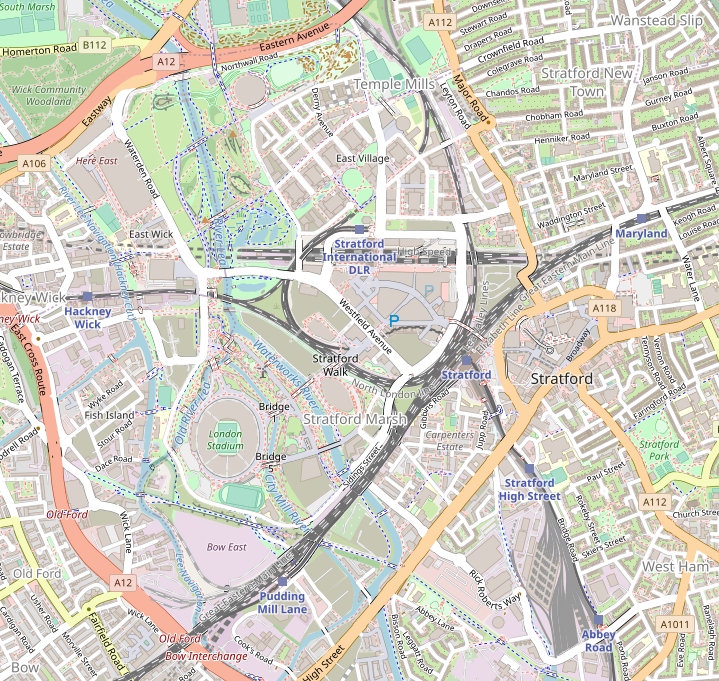
We suggest viewing this online (opens in new window or tab)
Source : openstreetmap.org © OpenStreetMap contributors
Additionally, a map of the rail network in this area is available from website cartometro.com (opens in new window or tab) by selecting from the list London transport which provides more detailed information than London lines. The detailed London transport map can be viewed online or as a png or pdf file. By selecting or zooming in on Stratford, detailed information can be viewed including platform numbering. South of Stratford at Pudding Mill Lane, the tracks for the Elizabeth line branch connecting on to the Great Eastern Main Line (GEML) are coloured purple, at least at the time of writing, with a tunnel portal at Pudding Mill Lane.
We note the potential for a connection from here on to the national rail line to Tottenham Hale. One option could be to connect to platforms 11 and 12 at Stratford on the north side of the Great Eastern Main Line (GEML) and then continue northwards. It is not clear whether this is feasible although, by reference to OpenStreetMap.org, it would seem that Sidings Street running parallel to the GEML does not need to remain as a through road. A possibility, in terms of achieving the connection, could be to relocate the Pudding Mill Lane tunnel portal to the northern side of the GEML. However in this case, if the Elizabeth line branch to Shenfield were to remain open, trains would be running on a different pair of tracks and no doubt with significant implications. These trains would call at Stratford platforms 9 and 10. Whilst this may be possible, we will give no further thought in this article to connecting Elizabeth line for Tottenham Hale to platforms 11 and 12 at Stratford.
By reference to OpenStreetMap.org, to the west of Stratford International there is a line on a north-east south-west orientation connecting in both directions on to the line to Hackney Wick and Stratford, being the North London Line. By zooming in, there is a reference to Lea Junction although this refers to the western of the three junctions i.e. nearest to Halfway Bridge. The two connections from the North London Line converge at Westfield Avenue / Waterden Road, this being High Meads Junction. The second option for connecting Elizabeth line to Tottenham Hale could be that the connection would cross the Olympic Park, possibly in tunnel and connect into High Meads Junction. Northwards from here, the line is covered over beneath a park and then runs beneath Liberty Bridge Road emerging again into open air to join the line from Stratford at Temple Mills East junction. Details can also be verified by reference to cartometro.com
This then is our hypothesised potential connection : crossing the Olympic Park, possibly in tunnel and connecting into High Meads Junction.
We suggest that a new station, provisionally named Stratford West, might be provided on this line, being the High Meads Loop. The location is illustrated below. Access to this new station would be shared with access to Stratford International DLR, lower right on the image. To construct the station, much of the park would close although the line would again be covered once construction was complete and the park then reopened.
An alternative is that trains might pass through without calling at a station at Stratford.
View of the High Meads Loop entering the covered section :
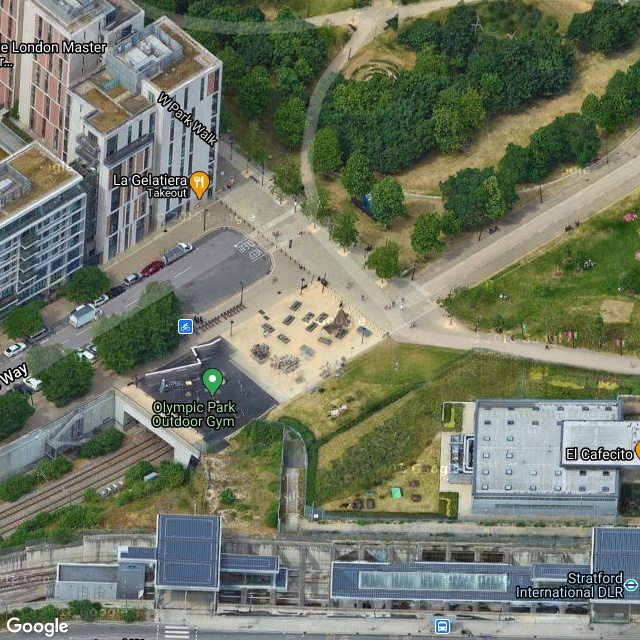
View of tracks prior to the covered section :
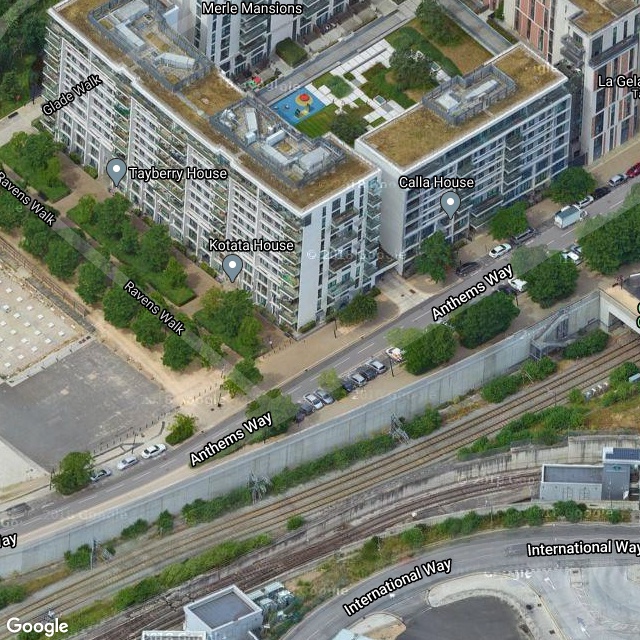
Another view of tracks prior to the covered section :
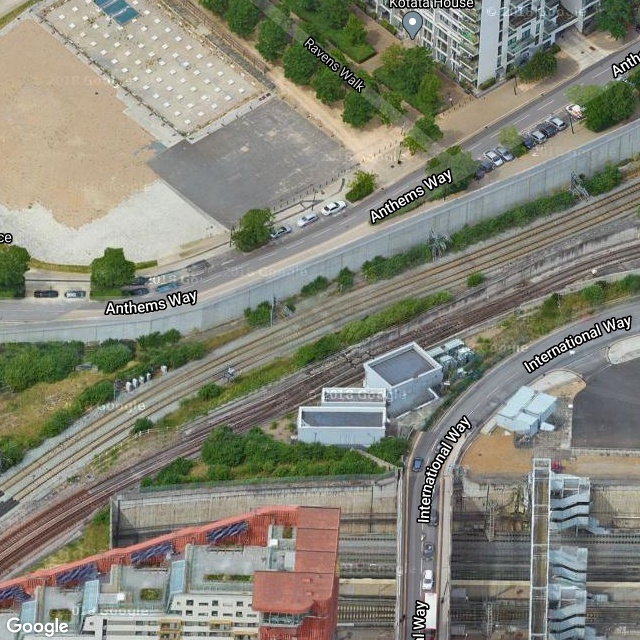
View of tracks from Westfield Avenue to the covered section :
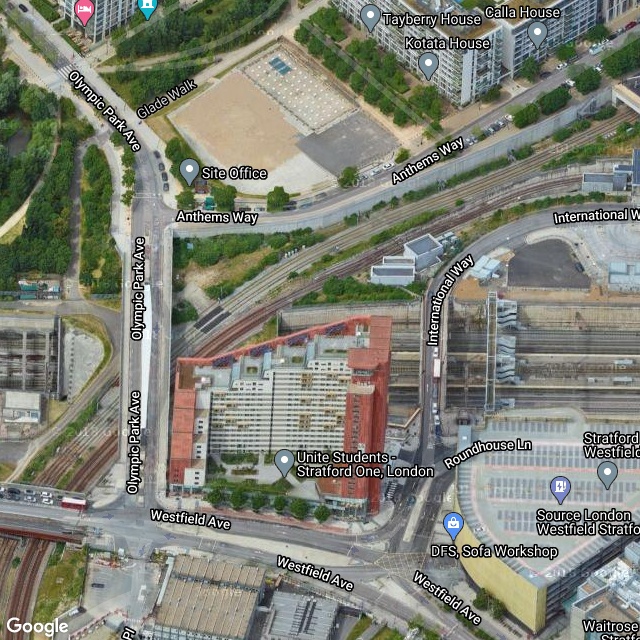
The view from Olympic Park Avenue emphasises that the tracks are not straight :
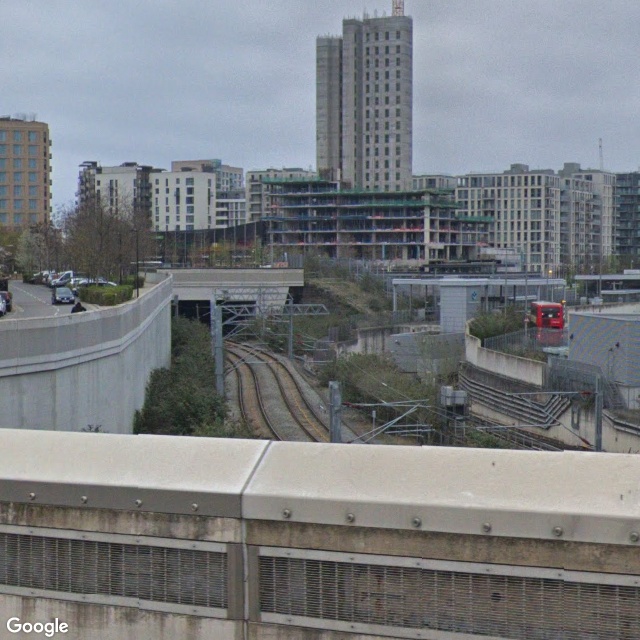
North of Stratford, the WAML might be upgraded from north of Lea Bridge to four tracks. A sample image of the existing line passing between Warwick Reservoirs West and East follows. At the time, a third track was in the process of being laid and which runs to Meridian Water station. The image shows that formerly there were four tracks between the reservoirs. Overall however an upgrade of the WAML to four tracks would present challenges.
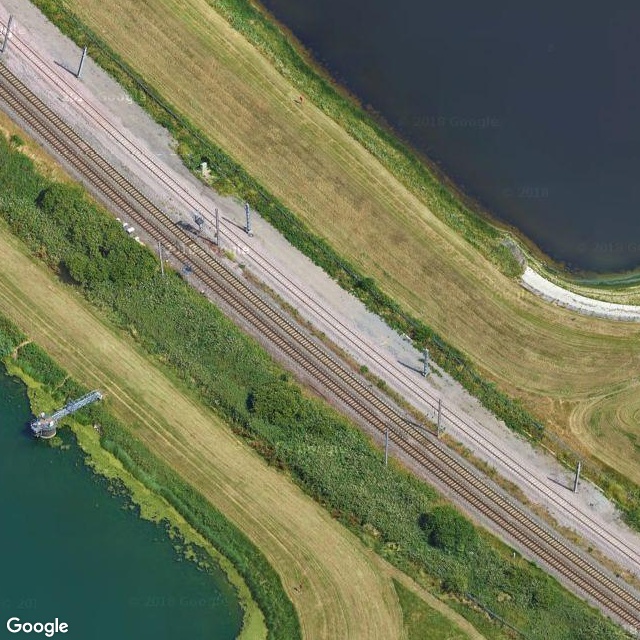
We suggested earlier in section "Tempsford to Stansted Airport", as an alternative to upgrading the WAML to four tracks, that Elizabeth line services might connect on to the branch to Chingford which would be extended northwards. A dismantled chord at Lea Bridge junction would be reopened, no relation to Lea Junction referenced earlier. Reopening this dismantled chord would enable Stratford to Chingford, specifically Lea Bridge to St James Street.
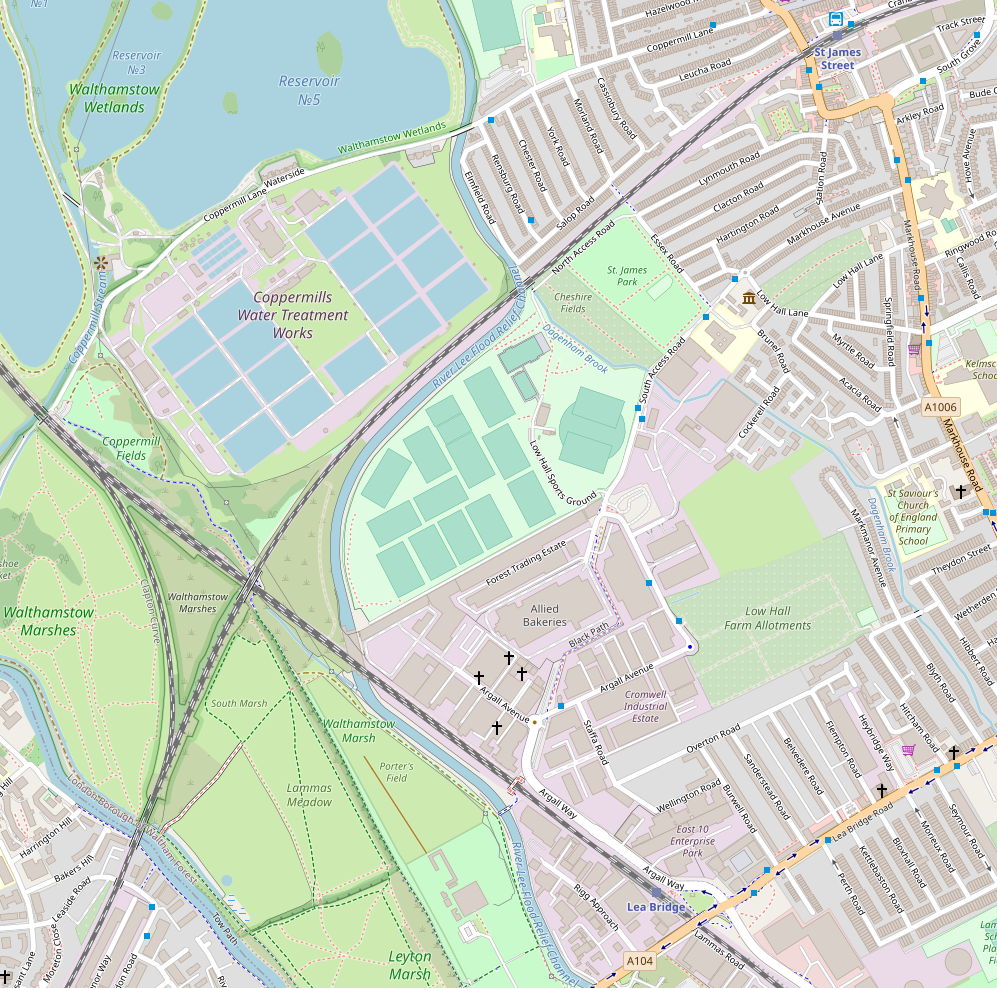
Reference openstreetmap.org : viewing this online (opens in new window or tab)
Source : openstreetmap.org © OpenStreetMap contributors
Google : viewing this online (opens in new window or tab)
On the cartometro.com map referenced earlier this dismantled chord is labelled as the Hall Farm curve.
Presumably Chingford station would be upgraded to four pass-through lines, at least the central two being served by platforms, enabling a service to terminate at Chingford as currently. Through services would potentially be held up by stopping services calling at some or all of the intermediate stations, which are St James Street, Walthamstow Central, Wood Street and Highams Park.
We have discussed upgrading the WAML to four tracks, noting that a third track has been laid as far as Meridian Water. We have also discussed extending the Chingford branch northwards. Combining these two, for use by non-stop services, we would seem to have the possibility of the WAML being upgraded to three tracks and with a single-track line northwards from Chingford. Alternatively three tracks on the WAML with a dual-track line northwards from Chingford, the latter in normal operation being used in one direction only.
Exercise for the reader : design a train scheduler i.e. computer software to evaluate this, new services coexisting with existing services adapted as necessary.
An Elizabeth line service from Edinburgh could be a candidate for consideration. Potentially the service might use a connection between Heathrow and Woking, resulting in a service Edinburgh - Elizabeth line - Heathrow - Portsmouth or Edinburgh - Elizabeth line - Heathrow - Southampton.
With a line from Tempsford to Stansted Airport and continuing southwards from the airport, Elizabeth line services to Stansted Airport would enable Elizabeth line services between Heathrow and Stansted airports. This would offer the option of expanding Stansted Airport as an alternative to a third runway at Heathrow and with some coordination between the two airports.
We would then seem to have the potential for Edinburgh - Stansted Airport - Elizabeth line - Heathrow.
The Shenfield branch of the Elizabeth line offers convenience but not improved connectivity. A longer-term proposal for the Elizabeth line might be better than filling the Elizabeth line tunnel with services in the short term.
We seem to have the potential for a Stansted Airport circular service : Stansted Airport, Elizabeth line, Heathrow, Woking, Camberley, Reading, Oxford, Bicester, Bletchley, Bedford, Tempsford, Stansted Airport. Some of the details required for this are available in our project : "London orbital services".
The ECML has four tracks from Stoke tunnel, south of Grantham, to London Kings Cross, except between Peterborough and Huntingdon and between Knebworth and Welwyn Garden City. There are only two tracks between Knebworth and Welwyn Garden City including two tunnels in succession, Welwyn North tunnel and Welwyn South tunnel and then Digswell viaduct. This bottleneck might be expected to be working at capacity but for the fact that Welwyn North station is located on the bottleneck.
Elizabeth line services on to the ECML would replace some existing ECML services via Welwyn and so take pressure off the two track section between Knebworth and Welwyn Garden City.
This ECML two-track section and the proposed Bedford to Cambridge railway line are in relative proximity. There is potential for interactions between them.
We support the proposal for a Bedford to Cambridge railway line in principle, however we have reservations about the current plan. It might be worthwhile to split the proposal into two phases. In the first phase, a facility for services eastwards from Bedford to join the ECML at Tempsford i.e. Bedford to Sandy and Stevenage. In the second phase, a direct line between Bedford and Cambridge via the Bassingbourn area would seem to be better future-proofed than a line via Cambourne.
We would like to suggest that a conventional rail tunnel beneath Cambridge, increasing the capacity for conventional rail at Cambridge, might be worthy of consideration as an alternative to Mass Rapid Transit (MRT) at Cambridge. Details would need to be determined. It is far from ideal for Cambridge connectivity and for a Bedford to Cambridge railway line to be assumed to be separate projects. Potentially a new Bedford to Cambridge line could connect directly into a new conventional rail tunnel beneath Cambridge, sharing use of the tunnel with services on other lines. The tunnel might also be used by light rail.
This project conjectures some longer-term possibilities. There are no specific proposals in this project.
Change control: there may be minor updates to diagrammatic maps without reference to this in the text.
RailEnable home page